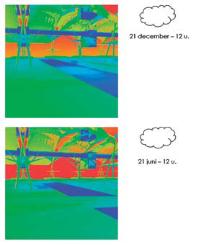SEO Version





52
3.2 Study of daylight entry and artifcial lighting
Study of daylight entry: search for visual comfort.
Light is one of the most important elements in architecture; light can, because of its
very nature, reveal the space, the shapes, the structures, and materials of a building
and give meaning to these elements. The entry of daylight into a building is never
neutral; a certain atmosphere is always created even if this is not done deliberately.
Visual comfort is a subjective impression connected to the amount, the dispersion,
and the quality of light. The visual environment gives us a feeling of comfort when
we are able to discern objects clearly and effortlessly in a pleasant atmosphere. This
presupposes an adequate dispersion of light in the specific space.
Visual comfort is an important key point of the design. The station cover is specifically
designed to increase the passenger’s level of comfort. Different parameters have a
direct influence on the quality of visual perception. The chosen light strategy is based
on four principles: concentration of sufficient light, controlled direction of light, even
dispersion, and protection of travelers from abundant sunlight and glare.
Leuven station is open to the outside via two kinds of openings: the facades and
the zenithal glass areas. Inside the station, canopies of mirror glass reflect the light
toward the vaults. The choice of white colour promotes the homogenisation of the
light dispersion.
Study of daylight entry: analysis aids.
The design of a successful day lighting system needs to take into account the
location and site of the project as well as the numerous daylight variations which
vary according to the season, day, hour, and weather conditions. The accurate study
of these phenomena is performed by powerful computer programs. We have opted
for Radiance software, integrated in the A passengers deline software package,
which creates simulations that allow us to evaluate the various premises in terms of
facilities and variants, both on a qualitative and a quantitative level.
Radiance is a program that calculates the clarity level within a given space using
an evaluation method based on inversed rays, in function of the place, the location,
the moment, and the weather conditions. The program works with a model of a full
scene in which light sources, sky, and neighbouring buildings, among others, are
integrated. The program is capable of calculating a view of any naturally lighted
scene, whatever its geometry. The surfaces of the model can be transparent,
mirroring, reflecting, diffuse, or translucent.
Radiance produces realistic three-dimensional figures of the rendered space; our
perception of the actual result is supported by the production of these figures.
The program also produces colour figures of the light dispersion in a space, where
every colour corresponds to a certain degree of lighting on a specific surface. This
allows us not only to evaluate the general lighting level in a given space, but also the
degree of light dispersion. In brief, this is an effective aid in terms of verification and
decision making.
Simulations
The project was examinedunder a clear sky, aswell as under a “standardCIE” clouded
sky, both taking the sun’s path across the sky into account. Both these opposite
weather conditions were simulated for two crucial times of the year: December 21st
with
light refecting glass
fig. 6
fig. 9
fig. 11
fig. 5
fig. 2
fig. 1
Powered by FlippingBook Publisher

